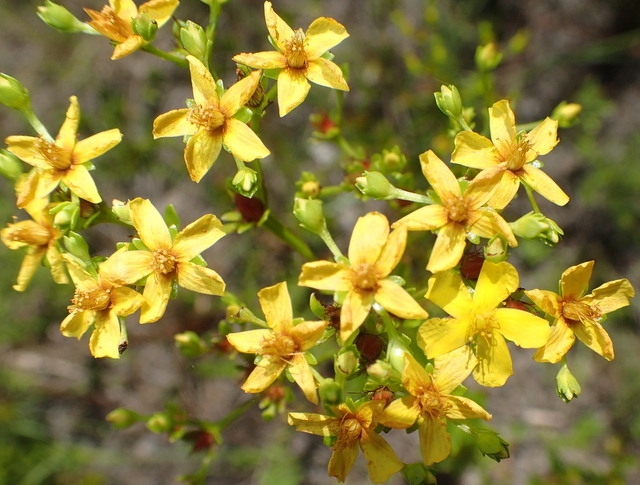Roundpod St. Johnswort
(Hypericum cistifolium)
Roundpod St. Johnswort (Hypericum cistifolium)
/
/

mfeaver
CC BY 4.0
Image By:
mfeaver
Recorded By:
Copyright:
CC BY 4.0
Copyright Notice:
Photo by: mfeaver | License Type: CC BY 4.0 | License URL: http://creativecommons.org/licenses/by/4.0/ | Rights Holder: mfeaver | Publisher: iNaturalist | Date Created: 2021-08-14T11:11:47-07:00 |















































Estimated Native Range
Summary
Hypericum cistifolium, commonly known as Roundpod St. Johnswort, is a perennial subshrub that is often deciduous or semi-deciduous in colder parts of its range. It is native to sandy soils in pine flatwoods, savannas, and roadside edges in the Southeastern United States. This plant typically grows to a height of 1-2 feet (0.3-0.6 meters) and can spread up to 3 feet (0.9 meters) wide. It features oblong to linear leaves and bears bright yellow flowers with numerous stamens, blooming profusely in the summer and providing a showy display.
Roundpod St. Johnswort is valued for its drought tolerance and the cheerful yellow flowers that attract pollinators such as bees and butterflies. It is used in native plant gardens, as a ground cover, and in restoration projects where its ability to thrive in poor, sandy soils is advantageous. It prefers full sun to part shade and requires well-drained soils, although it can tolerate occasional flooding. While generally low-maintenance, it can be susceptible to rust and leaf spot diseases. This species is not known for aggressive roots or significant invasiveness, but care should be taken to prevent the spread of diseases by providing good air circulation and avoiding overhead watering.CC BY-SA 4.0
Roundpod St. Johnswort is valued for its drought tolerance and the cheerful yellow flowers that attract pollinators such as bees and butterflies. It is used in native plant gardens, as a ground cover, and in restoration projects where its ability to thrive in poor, sandy soils is advantageous. It prefers full sun to part shade and requires well-drained soils, although it can tolerate occasional flooding. While generally low-maintenance, it can be susceptible to rust and leaf spot diseases. This species is not known for aggressive roots or significant invasiveness, but care should be taken to prevent the spread of diseases by providing good air circulation and avoiding overhead watering.CC BY-SA 4.0
Plant Description
- Plant Type: Shrub, Herb, Subshrub
- Height: 1-2 feet
- Width: 2-3 feet
- Growth Rate: Moderate
- Flower Color: Yellow
- Flowering Season: Summer
- Leaf Retention: Deciduous, Semi-Deciduous
Growth Requirements
- Sun: Full Sun, Part Shade
- Water: Medium
- Drainage: Fast
Common Uses
Bee Garden, Bird Garden, Butterfly Garden, Deer Resistant, Groundcover, Low Maintenance, Showy Flowers
Natural Habitat
Native to sandy soils in pine flatwoods, savannas, and roadside edges in the Southeastern United States
Other Names
Common Names: Round-Pod St. John’s-Wort
Scientific Names: , Hypericum cistifolium, Hypericum nudiflorum, Hypericum opacum, Hypericum rosmarinifolium, Brathydium hyssopifolium, Hypericum punctulosum, Myriandra rosmarinifolia,
GBIF Accepted Name: Hypericum cistifolium Lam.